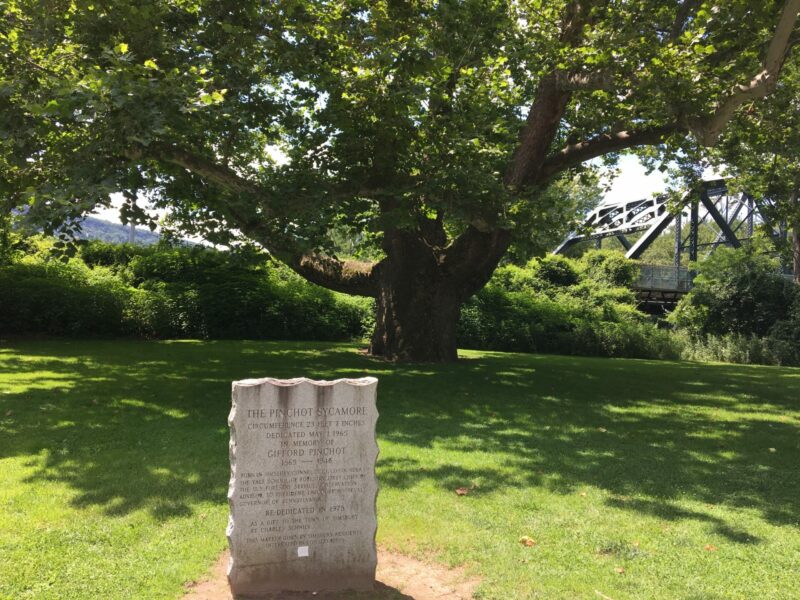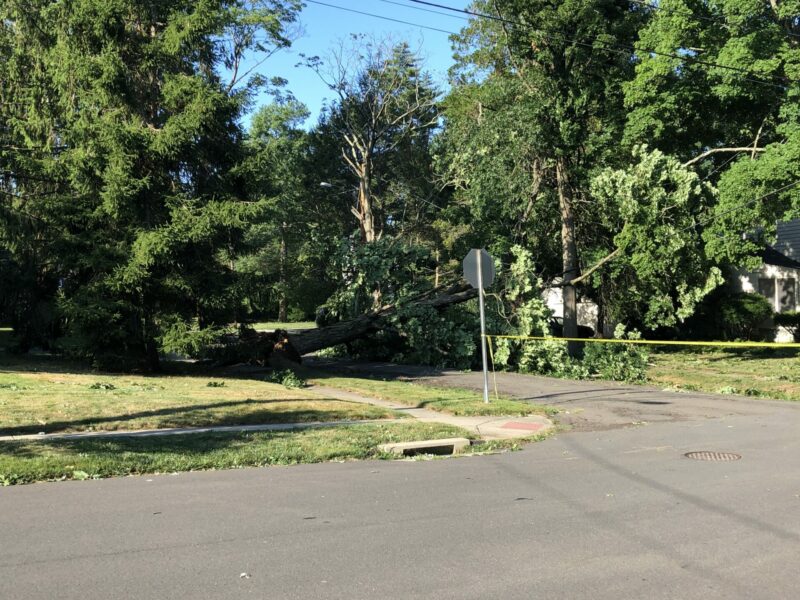Guidelines for historic tree preservation
05 October 2021 – Leah Glaser
Editor’s note: This is our first installment following an introduction by David Glassberg and Donna Graves for the “Public Historians in Our Climate Emergency” series. In Leah S. Glaser’s post, she reminds us of how trees and tree preservation play an important role in public history.

Baby Groot, in the 2014 movie “Guardians of the Galaxy.”
In the film, Guardians of the Galaxy, a sentient tree being sacrifices himself to save the universe from enemies in space. His friend, Rocket Raccoon, replants him in grief. Over several films, Groot, like earthbound trees, regenerates and continues his heroic activities alongside superhumans to preserve life throughout the universe. Public historians need to tap our superpowers to protect and preserve trees as keepers of our places, as well as our planet. While we root stories in places, we rarely give vegetation the same attention as buildings and structures. Efficient resource management should supplement ecological conservation practices with historic documentation, evaluation, and preservation.
Shifting global temperatures in just the last two decades have generated wildfires, tornados, hurricanes, and superstorms, causing the widespread felling of large trees and major power outages as they pulled down electrical lines. The response of utilities—eliminating roadside trees—threatens earth’s most effective warriors for reducing carbon emissions. After the devastating 1938 hurricane in the Northeast, newspaper articles and editorials called not for removing urban trees, like today’s response, but for prudent pruning and re-planting, citing the aesthetic, environmental and health benefits—arguments that remain consistent with today’s grassroots tree advocates. Power lines and the practice of forestry evolved side-by-side as material benefits equally essential to our early-twentieth-century quality of life in rural, suburban, and urban settings. Mature trees improve air quality, provide shade, conserve water, aid in flood control, and reduce soil erosion. They limit visual and noise pollution, reduce blood pressure, encourage physical activity, and improve overall mental health. Most importantly mature trees absorb more carbon dioxide than younger ones, serving as essential generals in the war on climate change. These facts struggle to gain political traction for tree preservation that overrides threats to the power grid. Could we also approach tree preservation policy from an additional historical perspective focused on human connection and sense of place?
In addition to conservation and forestry, environmental historians have crafted engaging narratives about trees, beginning with Eric Rutkow’s American Canopy (2012). Jared Farmer framed trees as unique “sites of discourse” in his book, Trees in Paradise (2013). Greg Gordan’s When Money Grew on Trees (2014) examines trees as an economic commodity, integral to the growth of industrial capitalism in the West. The lumber industry evolved from regional cultures, as well as local climate, topography, and soils. Trees provide building material and food, and aesthetic allure for the recreational and tourist industries. National and state forests began as ways to publicly and sustainably manage trees to ensure the lumber supply, but forest management helps historically document climatic changes. Shephard Krech’s The Ecological Indian (2000) and Theodore Catton’s Indians and the National Forests (2016) trace Native practices and how Indian policy interacted with that of the Forest Service. Thomas Campanella’s Republic of Shade (2003), Ellen Stroud’s Nature Next Door (2012), Jill Jonnes’ Urban Forests (2016), and Sonja Dumpelmann’s Seeing Trees (2019) detail how trees evolved with urbanization. Even if they have since died off, tree types identify and unify certain communities’ identities. Elm Street or Maple Street inscribe streetscapes across the United States, even if only in place names.
The presence (or absence) of trees in certain neighborhoods and communities reflect patterns of inequality and shape impacts of contemporary climate injustices. Urban development and renewal prompted the clearing of woodlands for expansion of the city or for suburbs, sometimes home to primarily poor, rural communities. While these newer neighborhoods included street trees, historians have noted the corollary between a lack of street trees and the historically pervasive “redlined” neighborhoods considered risks for housing loans due to their high percentages of poor, African American, or Latino residents. Aside from aesthetic benefits, the lack of mature trees means hotter neighborhoods by nearly five degrees. This association between trees, race, housing, wealth, and health illustrates the inextricable links between cultural practices and climate change.
The cultural landscape model emerged in the 1990s to describe “cultural properties [that] represent the combined works of nature and of man.” The National Park Service’s technical bulletins explain vernacular and “rural historical landscapes.” A revision of David L. Ames and Linda Flint McClelland’s bulletin on suburbanization could include the development of street trees. We can also evaluate roadside trees as linear resources.
Like other objects of material culture, trees are artifacts through which to explore both natural and cultural history. Thomas Schlereth, a leading advocate for material culture, observed that tree plantings can mark historic migration or travel routes, document patterns of land ownership, mark settlements and property lines, influence housing types and local industry, not to mention explore ideas about recreation, aesthetics, public memory, and public health.

Connecticut’s largest tree is dedicated to the chief of the National Forest Service and native of Simsbury Gifford Pinchot. The over 500-year old tree “witnessed” the burning of Simsbury during King Phillip’s War in 1676. 2018. Photo credit: Leah S. Glaser
Mature forests supplied Native people of the eastern woodlands with tools, shelter, and food as they kept seasonally mobile between inland forest and shoreline. “Witness trees” locate and recall communal stories such as treaty signings, meetings, or battles. Known to local Native people as a “peace tree,” white settlers reclaimed what is now known as the Charter Oak for Connecticut’s own creation story. Some trees hold painful memories of loss and/or serve as both symbols of terror and memorials to victims of racial oppression for thousands of lynched African Americans, Latinos, and others.

Just one intersection of dozens in the author’s tree-lined neighborhood where severe storms felled large street trees that in turn pulled down powerlines. August 2020. Photo credit: Leah S. Glaser
The commemorative role of trees and tree groves, akin to stone monuments, may qualify for the National Register, under Criteria Consideration F. Many states keep databases of notable trees (albeit absent of historical context). Existing nominations and contexts include some models. The distribution and re-planting of commemorative tree saplings have become a time-honored, often communal, ritual, involving “germplasm conservation” to preserve species. In-kind, or environmentally sustainable “replacement,” captures the function and spirit of restoration. A last, but critical, tool for tree preservation is to craft ordinances across disciplines to protect older trees as community assets, as well as landmarks contributing to a sense of place. History does not always provide the solution, but it can help (forgive me), “see the forest through the trees.”
~Leah S. Glaser is a professor of history and the coordinator of the Public History Program at Central Connecticut State University. She helped found NCPH’s Committee on Environmental Sustainability and served as its first chairperson. Dr. Glaser is currently co-editing a book with Dr. Philip Levy entitled Branching Out: The Public History of Trees, under contract with the University of Massachusetts Press.




Where do I find the process and application for this program?
We, too, would like to preserve our historic trees. And need guidance to do so. We are witness to many giant tree fellings in our small historic village, that has been listed on the historic Register since the 70’s. The wind of whichever current mayor and road commissioner seems to impact how many and how often trees are felled. We lost two giant cedars in our grave yard a couple of years ago, due to seemly “rotted” areas in the trunks. Also, this winter, a grand burr oak that was a perfect specimen, minus a small rotted area in the base (of over 8 feet in diameter). After felling, the oak was found to be totally sound at the point of branching, some 20 feet up, and should never have been subject to the whims of the over zealous road commissioner who threatened with “liability and utility damage” both of which scared the village board into promptly paying $2000 of its small budget to cut it down. The ring count at 20 feet was 138 – it was a baby when the village was established. These great trees need saving.